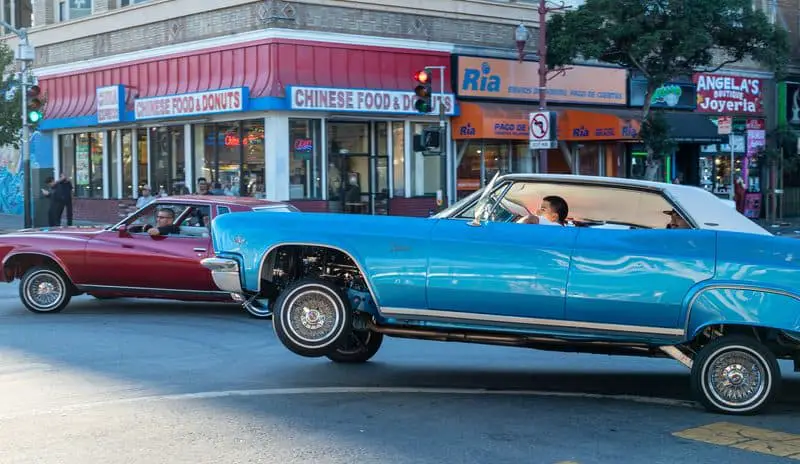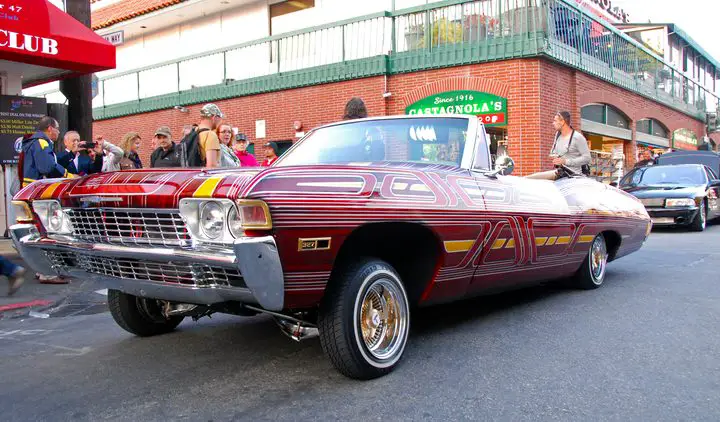
They’re called lowriders. We’ve seen them, admired them, and probably shook our heads and raised our eyebrows in disbelief as they cruise slowly down the road, “low and slow,” wearing their unblemished, unique, and intricate paint jobs and every now and then jumping right up into the air.
It’s spectacular, alright, but how do they make those cars bounce up and down like that?
Bouncing the car up and down is done by fitting an air or hydraulic suspension, with pumps and valves that are activated by the driver, using a control unit. The initial reason for this adjustable suspension was to bypass local laws banning cars with bodywork lower than the bottom of its wheelrims.
Not all lowriders are fitted with this form of suspension, but it’s become the norm and part of the lowrider culture. And it is a culture – there is a history that goes back to the 1940s, and it’s interesting to track that history and then look in detail at how these cars perform their high jumps.
How Do They Make Cars That Bounce?
Before looking at the engineering that goes into making a car bounce, it is interesting to investigate how this phenomenon began, who originated the practice, and why.
The bouncing car developed from the need for a simple adjustable suspension, and that’s where the story begins.
The First Lowriders Didn’t Bounce
When the car became a part of postwar American culture in the 1940s, hot rods were the rage throughout the country.
In Texas, the Southwest, and California, however, Mexican Americans, Chicanos, took a different route to define their separate culture and began creating lowriders with elaborate paintwork, extravagant chrome, small wire wheels with whitewall tires, and lowered suspension.
These unique mobile works of art became more and more popular in the ‘50s and ‘60s, and by the ‘70s had become a symbol of the Chicano and black civil rights movement.
Car clubs, parades, and competitions brought lowriders into the public eye. Reaction to this resulted in a Californian law banning cars where any part was lower than the bottom of the wheelrim.
The First Lowrider With Adjustable Height Suspension
In 1959 a specialist in lowrider customizing, Ron Aguirre, created the first adjustable suspension using hydraulic Pesco pumps and valves, which lifted the car’s body above the minimum height and thus satisfied the condition of the law.
Lowriders became more and more popular, appeared in movies, and featured in hip-hop and rap music until they were not just a West Coast phenomenon but a worldwide one.
Builds and modifications became increasingly elaborate, the spectacle of raising and lowering the cars increasingly extreme, and more and more a requirement for the ultimate lowrider.
The iconic lowrider has always been the 1964 Chevrolet Impala, whose X-shaped frame was perfect for accommodating all the hydraulics required for the lowered suspension.
With its beautiful exterior and enormous trunk for carrying the bulky components required for the hydraulics, it was the car of choice for many.
The Suspension Mechanics Of Bouncing Lowriders

Most lowriders use an adjustable air suspension to raise and lower the car. It’s relatively easy to install and the least expensive option, but a hydraulic suspension using liquid “juice” instead of air is what the best competition-winning lowriders install.
An air suspension system involves replacing the conventional metal springs in the suspension with very strong airbags.
Each bag is connected to an air reservoir, and there is a strong compressor that will pump air into each airbag when it receives the electrical “instruction” from the control unit. In this way, the airbag is inflated or deflated, raising or lowering each corner of the car.
An air suspension system is relatively easy to install and provides a soft, comfortable ride and good handling.
However, while it makes the lowrider go up and down, it’s not going to make it bounce into the air. For that spectacular six-foot-off-the-ground action, a hydraulic suspension is the only choice.
A hydraulic suspension works on the same principle as air suspension but operates more quickly and effectively. Where the air suspension replaces each spring with an airbag, in a hydraulic system, the spring is removed and replaced with a hydraulic actuator.
This actuator may be in the form of a bladder in a lowrider but is usually a cylinder housing a piston that is moved upward by pumping in a liquid at very high pressure.
Using the same principle as air suspension, the hydraulic system shoots fluid into the bladder, which expands very rapidly, pushing the suspension components upwards or outwards with great force and causing the car to jump before returning to earth. Removing oil from the bladder has the opposite effect.
The parts required for this type of suspension include the actuators, oil tanks to hold the hydraulic oil, pumps, connecting pipes, valves, control modules, and batteries.
The complexity of the system varies according to what set-up is required. Some owners will have two actuators, and others will want one for each wheel, each with its own pump. The hydraulics may also be used to open and close the trunk and hood lid, activate doors, and other functions, which will require additional batteries and a more intricate network of pipes and pumps.
The cost of the basic system is not high, but it could run to several thousand dollars for the top-of-the-range hydraulic system.
Advantages And Disadvantages Of Hydraulic Suspension
Hydraulic suspension systems are preferred to air suspension because:
- They exert up to 25 times the pressure, up to 4000 psi.
- They hold that pressure for longer without additional oil being pumped in
- The tanks can be placed quite far from the actuators with minimal pressure loss.
The main disadvantage of hydraulic suspension is that it tends to leak because of the high pressure in the system.
While the system is reasonably simple, it requires constant maintenance to keep it performing optimally and to keep the car looking immaculate.
Conclusion
While a car bouncing up and down may just be a sign of worn-out shocks, the art of making a lowrider jump six feet into the air, or ride the boulevard on three wheels, is what makes this type of car so special.
The bouncing lowrider was created out of a need to be different and has become a unique automobile culture and one which continues to grow around the world.
